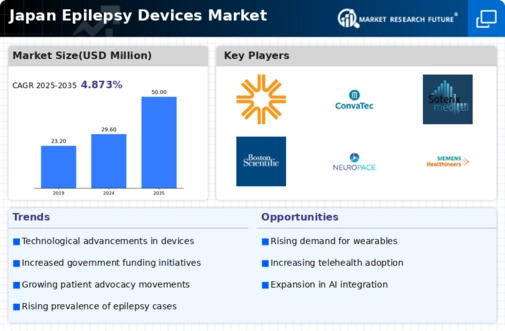Rising Incidence of Epilepsy
The increasing prevalence of epilepsy in Japan is a crucial driver for the epilepsy devices market. Recent statistics indicate that approximately 1 in 200 individuals in Japan are diagnosed with epilepsy, leading to a growing demand for effective management solutions. This rising incidence necessitates the development and adoption of advanced devices that can assist in monitoring and controlling seizures. As the population ages, the incidence of epilepsy is expected to rise further, thereby propelling the market forward. The epilepsy devices market is likely to see innovations aimed at improving patient outcomes, which may include wearable devices and implantable technologies that provide real-time data to healthcare providers.
Rising Awareness of Epilepsy Management
There is a notable increase in awareness regarding epilepsy management in Japan, which serves as a significant driver for the epilepsy devices market. Public health campaigns and educational initiatives are helping to destigmatize epilepsy and promote understanding of the condition. As awareness grows, more individuals are seeking effective management options, including the use of specialized devices. This trend is likely to lead to an increase in demand for innovative solutions that cater to the needs of patients. The epilepsy devices market may experience growth as a result of this heightened awareness, encouraging manufacturers to develop products that align with patient expectations and improve quality of life.
Technological Integration in Healthcare
The integration of advanced technologies into healthcare systems in Japan is significantly influencing the epilepsy devices market. The adoption of telemedicine and digital health solutions is on the rise, allowing for better patient monitoring and management. For instance, the use of mobile applications and wearable devices enables patients to track their seizure activity and share data with healthcare professionals. This technological shift is expected to enhance the quality of care and improve patient engagement. The epilepsy devices market is likely to benefit from these advancements, as they facilitate timely interventions and personalized treatment plans, ultimately leading to better health outcomes.
Growing Support from Healthcare Professionals
The support and advocacy from healthcare professionals play a pivotal role in the growth of the epilepsy devices market. Neurologists and epilepsy specialists in Japan are increasingly recognizing the importance of utilizing advanced devices for patient management. Their endorsement of these technologies can lead to higher adoption rates among patients. Furthermore, healthcare professionals are likely to educate patients about the benefits of using these devices, which may enhance compliance and improve treatment outcomes. The epilepsy devices market stands to gain from this professional support, as it fosters a more informed patient population that is willing to embrace new technologies.
Increased Investment in Research and Development
Investment in research and development (R&D) within the healthcare sector is a vital driver for the epilepsy devices market. In Japan, both public and private sectors are allocating substantial funds towards the development of innovative epilepsy management solutions. This focus on R&D is expected to yield new devices that are more effective and user-friendly. The epilepsy devices market may witness breakthroughs in technology, such as improved neurostimulation devices and advanced monitoring systems. As a result, the market could expand significantly, with new products entering the market that cater to the specific needs of patients and healthcare providers.






















Leave a Comment